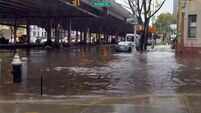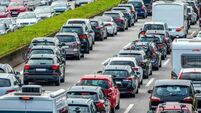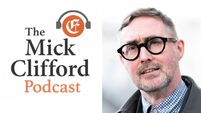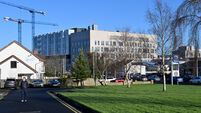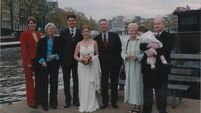Catherine Conlon: Cars are not the future of transport

Green Party Leader Eamon Ryan is optimistic that transformative change in how we move about our towns and cities will happen.
"On my watch, the great American road trip is going to be fully electrified," President Joe Biden tweeted recently as he announced the up-to $7,500 federal tax credit Americans can receive for buying a new electric vehicle (EV), while sitting inside a new all-electric 9,000 pound Hummer.
What is completely missing from this announcement is how overhauling the global car fleet to meet climate targets is not just about how cars work. It is also about how big they are. A car that weighs 9,000 pounds poses both a threat to pedestrians as well as consuming a lot of energy to drag around on city streets or country roads.
Norway, the global leader of EVs, understands this. Last year 87% of new cars purchased were at least partially powered by electricity. This has happened because of government incentives, including the exemption from the country’s 25% VAT rate and road tax, as well as reduced parking and ferry tolls, and discounted parking.
But now Norway is implementing new taxes on car purchases that scale with vehicle weight. Although the fees are much higher for internal combustion engine cars, owners of EVs must pay them also — at a rate of NOK 12.50 (€1.16) per kilogram. For larger EVs, the added expense can be substantial. One of Norway’s most popular cars, the Audi e-tron, now costs almost €2,500 more than it did before the introduction of the weight tax.
This approach is about addressing two key aspects of oversized EVs that have been highlighted by Tom Stacey, Senior Lecturer in Anglia Ruskin University.
When they do strike pedestrians they are more likely to cause serious injury and death, especially over 20mph.
Norway’s policy of introducing a weight-based tax nudges buyers away from the largest and most damaging cars to smaller cars. The policy impacts especially hard on oversized diesel or petrol-driven cars, potentially adding tens of thousands of euros to the price. The policy acknowledges the inefficient use of fossil fuels by SUVs while acknowledging the costs imposed by supersized EVs as well.
This policy could be used as a template for reducing the market share of SUVs in Ireland by incentivising Irish buyers to move to smaller-sized EV options.
Focusing on EVs as the future of transport policy, however, does not facilitate what is most needed — a societal shift in thinking of how best we use space to move away from cars altogether to more public transport and active travel.
This dilemma was highlighted last year when An Bord Pleanála took the decision to reject the Galway Ring Road after they admitted to failing to take the Climate Action Plan into account when signing off on the road, followed by a recent High Court decision to formally quash the planning permission for the long-planned ring road around the city.
The decisions by An Bord Pleanála last October was followed by a statement from Irish Doctor’s for the Environment (IDE) which suggested that the proposed solution to the congestion in Galway was archaic "perfectly abiding to the fundamental law of congestion, namely an increased provision of road does not relieve congestion." The evidence has consistently shown that more roads lead to more traffic and congestion. The proposal completely ignored the climate crisis and Ireland’s emissions targets.
The IDE pointed out that the ring road was estimated to cost €1bn.
"For that money, we could reimagine Galway and turn it into a model sustainable city of the future, a city that does not prioritise car drivers but the health of its citizens and the planet."
Barcelona has attempted to incentivise citizens away from cars by offering a free transit travel pass for three years, for citizens who chose to get rid of an older and less efficient car. France and Finland have been offering incentives for drivers to trade in their old cars for an e-bike instead. In Finland, the scheme allows users to choose between transit passes, incentives towards a new car, or an e-bike. Some research has shown that initiatives promoting bikes and e-bikes are twice as effective as those promoting electric cars.
For the last 100 years, transport strategies in cities and towns across Ireland have prioritised cars and traffic speed flows. Today, the places with the most successful transport strategies are prioritising the movement of people, giving residents and visitors a wider variety of attractive transport options.
The Cork Metropolitan Area Transport Strategy (CMATS) 2040 envisages the development of a transformed bus system, an enhanced commuter rail system, a new east-west light rail line, and a comprehensive cycling network providing safe cycling and pedestrian facilities across the region. The plan is to invest in high-quality cycling facilities segregated from bus lanes and general traffic lanes "as far as is practicable" and to "remove many of the conflicts between general traffic, buses, and cyclists." The degree of independence of cycle lanes from other traffic will be crucial in the ambition to shift adults and children alike to travel across the city by bike.
That process has started with major infrastructural work currently being undertaken in the city centre. Citizens are frustrated with aggravated congestion as the city grinds to a halt but are asked to be patient until the infrastructure is completed and the long- overdue works pay dividends.
January saw the publication by the National Transport Authority of the 20-year strategy for the Greater Dublin Area (GDA), setting out a plan for the capital and its surrounding counties.
The strategy is for cities and also towns across the area to prioritise and transform public transport and active travel that is centred around a comprehensive rail network analogous to the type of rail network in place over 100 years ago except that it will be cleaner, faster, and better value for money.
Climate Law requires a reduction in overall transport emissions by 51% by 2030, moving to net zero by 2050. This makes the move from a car-based lifestyles in the next decade inevitable.
Minister for Transport Eamon Ryan is optimistic that transformative change in how we move about our towns and cities will happen.
"I see no reason why Dublin should not be like Copenhagen or Amsterdam. We are a relatively flat, dry city where most trips are still quite short, coupled with a real tradition of cycling."
I agree. Cork is even more amenable to active travel and cycling with its higher density per square kilometre (5,766) compared to Dublin (4,665), and smaller size. Fewer cars on the road mean cleaner air and cycling that is quicker, safer, and much more enjoyable as well as providing a daily workout for heart, muscles, bones, and brain. Decent infrastructure will incentivise the move away from cars and allow public transport to move more fluidly through the city, offering a better service.
All we need now is a collective leap of faith as we step out of our cars and embrace a new way of moving around that is centred around public transport and active travel.
CLIMATE & SUSTAINABILITY HUB



